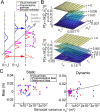Different Sensory Information Is Used for State Estimation when Stationary or Moving
- PMID: 39147580
- PMCID: PMC11376429
- DOI: 10.1523/ENEURO.0357-23.2024
Different Sensory Information Is Used for State Estimation when Stationary or Moving
Abstract
The accurate estimation of limb state is necessary for movement planning and execution. While state estimation requires both feedforward and feedback information, we focus here on the latter. Prior literature has shown that integrating visual and proprioceptive feedback improves estimates of static limb position. However, differences in visual and proprioceptive feedback delays suggest that multisensory integration could be disadvantageous when the limb is moving. We formalized this hypothesis by modeling feedback-based state estimation using the long-standing maximum likelihood estimation model of multisensory integration, which we updated to account for sensory delays. Our model predicted that the benefit of multisensory integration was largely lost when the limb was passively moving. We tested this hypothesis in a series of experiments in human subjects that compared the degree of interference created by discrepant visual or proprioceptive feedback when estimating limb position either statically at the end of the movement or dynamically at movement midpoint. In the static case, we observed significant interference: discrepant feedback in one modality systematically biased sensory estimates based on the other modality. However, no interference was seen in the dynamic case: participants could ignore sensory feedback from one modality and accurately reproduce the motion indicated by the other modality. Together, these findings suggest that the sensory feedback used to compute a state estimate differs depending on whether the limb is stationary or moving. While the former may tend toward multimodal integration, the latter is more likely to be based on feedback from a single sensory modality.
Keywords: feedback delays; multisensory integration; proprioception; state estimation; vision.
Copyright © 2024 Wong et al.
Conflict of interest statement
The authors declare no competing financial interests.
Figures






Update of
-
Different sensory information is used for state estimation when stationary or moving.bioRxiv [Preprint]. 2024 Jun 29:2023.09.01.555979. doi: 10.1101/2023.09.01.555979. bioRxiv. 2024. Update in: eNeuro. 2024 Sep 4;11(9):ENEURO.0357-23.2024. doi: 10.1523/ENEURO.0357-23.2024. PMID: 37732193 Free PMC article. Updated. Preprint.
Similar articles
-
Different sensory information is used for state estimation when stationary or moving.bioRxiv [Preprint]. 2024 Jun 29:2023.09.01.555979. doi: 10.1101/2023.09.01.555979. bioRxiv. 2024. Update in: eNeuro. 2024 Sep 4;11(9):ENEURO.0357-23.2024. doi: 10.1523/ENEURO.0357-23.2024. PMID: 37732193 Free PMC article. Updated. Preprint.
-
Dynamic Multisensory Integration: Somatosensory Speed Trumps Visual Accuracy during Feedback Control.J Neurosci. 2016 Aug 17;36(33):8598-611. doi: 10.1523/JNEUROSCI.0184-16.2016. J Neurosci. 2016. PMID: 27535908 Free PMC article.
-
Integration of proprioceptive and visual feedback during online control of reaching.J Neurophysiol. 2022 Feb 1;127(2):354-372. doi: 10.1152/jn.00639.2020. Epub 2021 Dec 15. J Neurophysiol. 2022. PMID: 34907796 Free PMC article.
-
The effect of proprioceptive training on multisensory perception under visual uncertainty.J Integr Neurosci. 2012 Dec;11(4):401-15. doi: 10.1142/S0219635212500276. Epub 2012 Dec 28. J Integr Neurosci. 2012. PMID: 23351049
-
Visuomotor adaptation and proprioceptive recalibration.J Mot Behav. 2012;44(6):435-44. doi: 10.1080/00222895.2012.659232. J Mot Behav. 2012. PMID: 23237466 Review.
References
-
- Bates D, Maechler M, Bolker B, Walker S (2015) Fitting linear mixed-effects models using lme4. J Stat Softw 67:1–48. 10.18637/jss.v067.i01 - DOI
MeSH terms
Grants and funding
LinkOut - more resources
Full Text Sources
Medical
